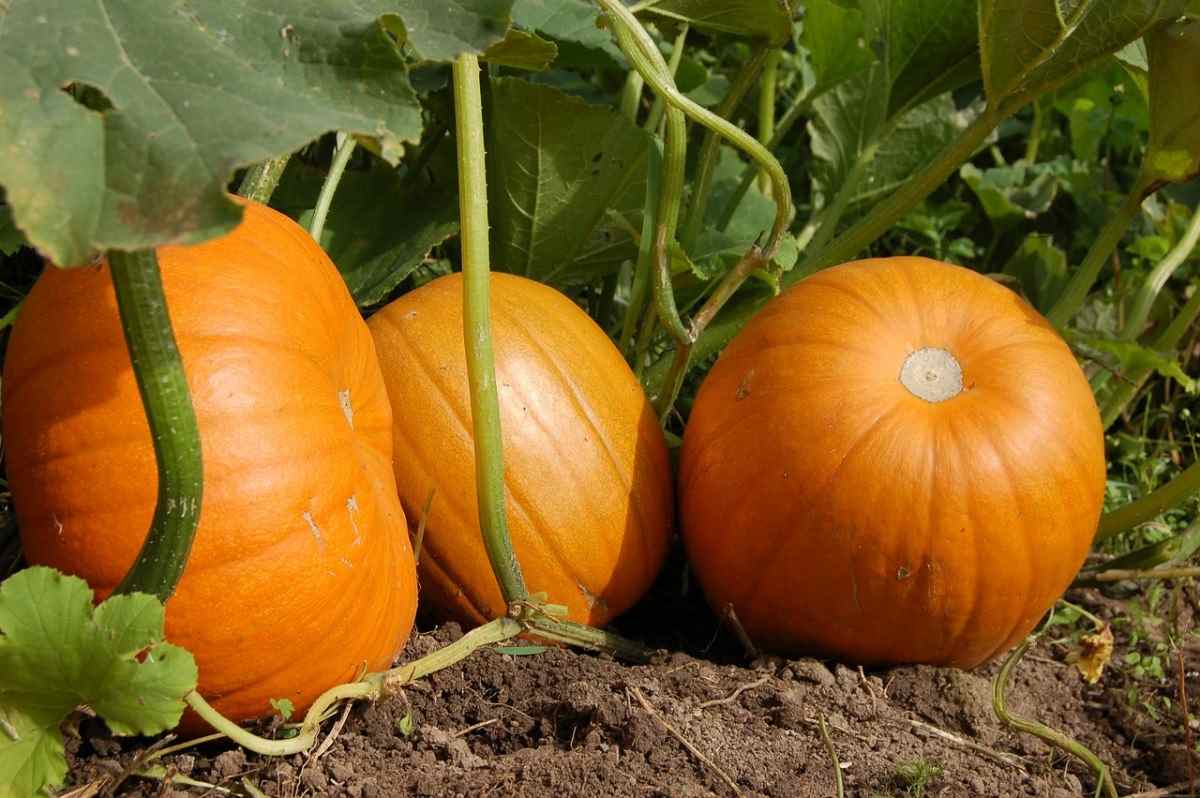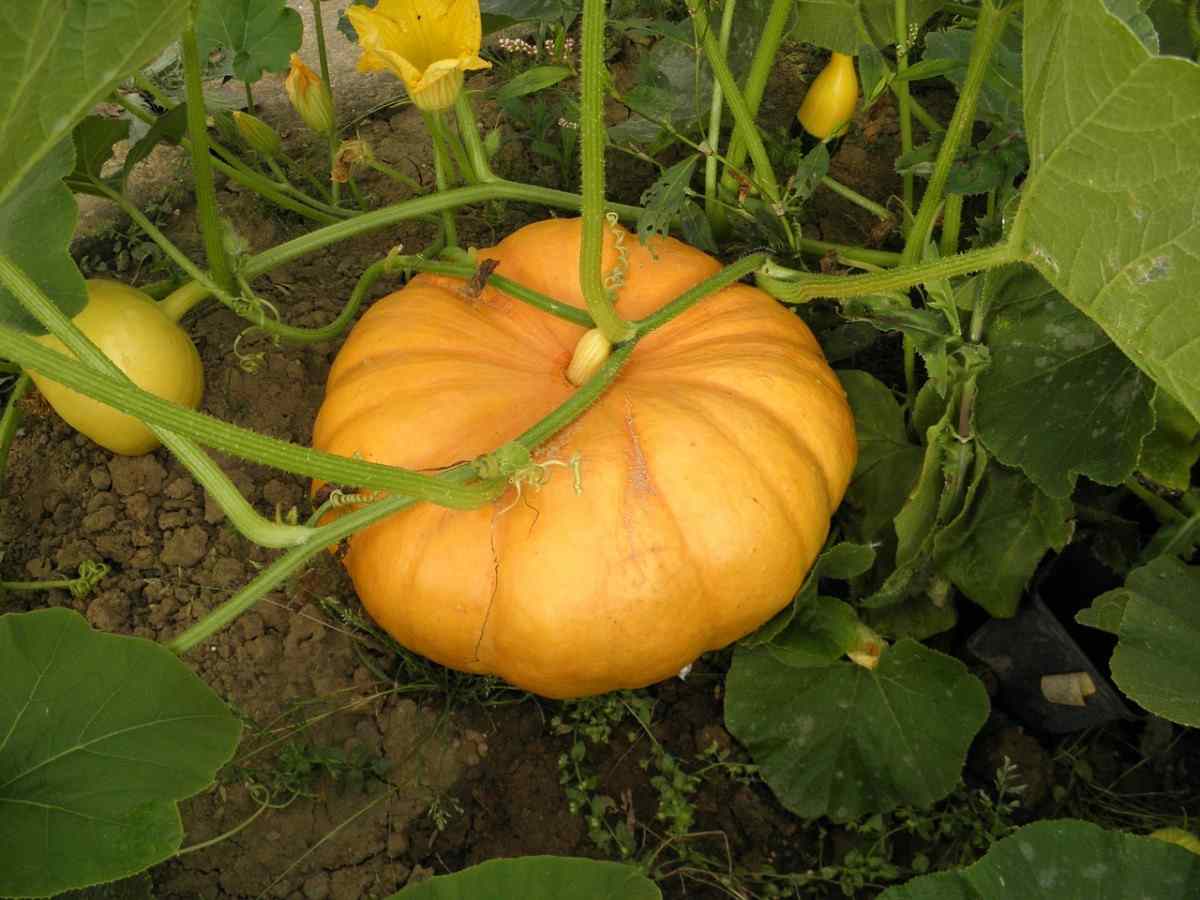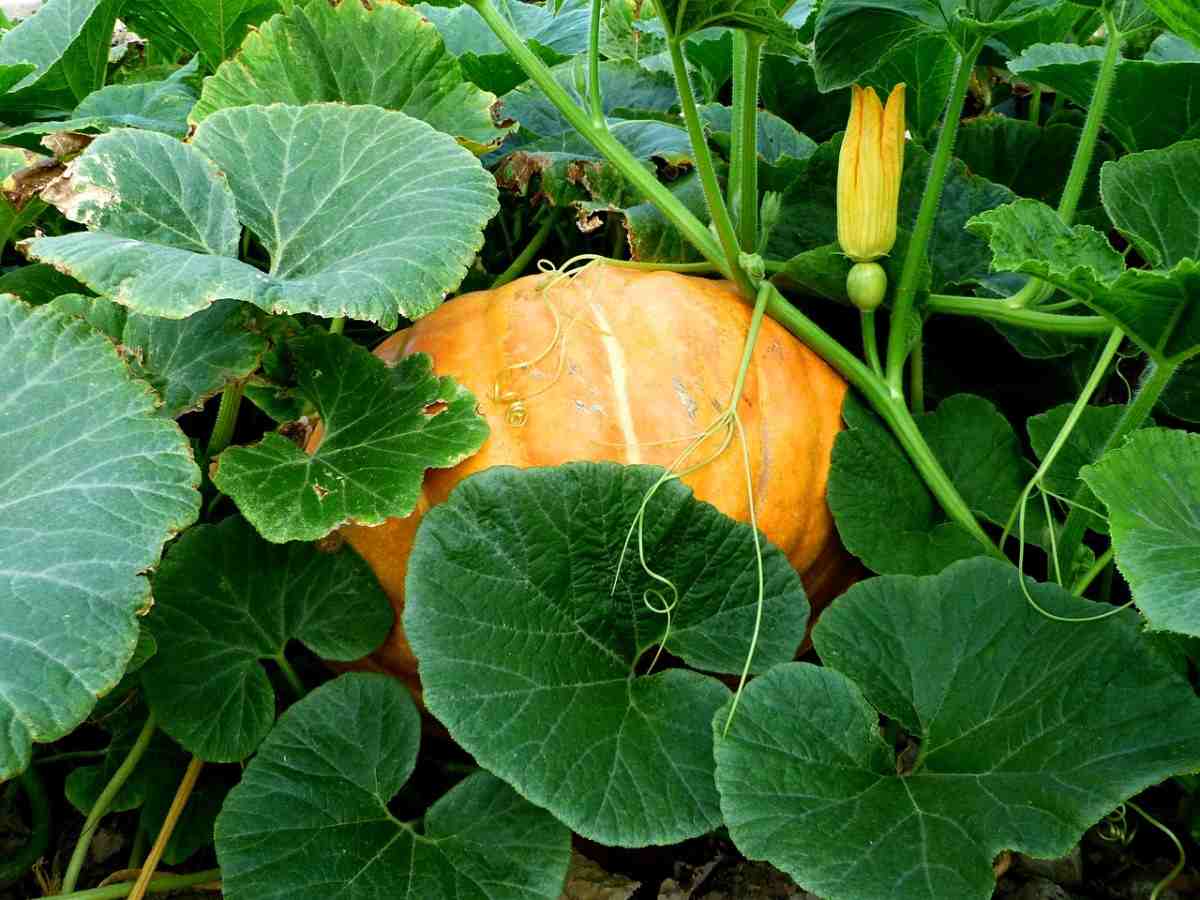Introduction on how to start Pumpkin Gardening for Beginners, Planting Questions, and Answers (FAQs): Hello gardeners, we are here with one more topic today. Do you want to plant a pumpkin plant and do you have any doubts about planting a pumpkin? Well and then you will need to follow this complete article to have a perfect pumpkin plant. In this article, we are going to discuss some frequently asked questions about planting pumpkins.
A pumpkin is a winter squash cultivar that is round with smooth, slightly ribbed skin and is often deep yellow to orange in colour. The seeds and pulp are contained within the thick shell.
Pumpkins are a fall staple, and there are countless types to choose from. You can pick from white or orange varieties, little or large sizes, carved varieties, and even ones that are ideal for baking pies. While you may always go the simple route and buy pumpkins from your local pumpkin farm, growing them entirely on your own can be just as much fun.
A Step-By-Step Guide to Pumpkin Gardening for Beginners, Questions, and Answers, Planting FAQs

The best way to grow pumpkins is to plant the seeds directly on the ground. Before putting seeds outside, wait until the soil temperature reaches 21°C or higher. The ideal soil temperature is 35°C. Pumpkins are delicate plants that are vulnerable to cold.
Choose a location that gets plenty of sunlight (to light shade).
Pumpkins also require a lot of room for their very expansive vines. Per hill, vine varietals require 50 to 100 square feet. However, if you only have a small garden, don’t worry. You need to plant pumpkins along the garden’s edge, with vines growing across the lawn or sidewalk. For a few weeks, the vines will be a nuisance. Pumpkins can also be grown in very large 5 to 10-gallon buckets. Alternatively, try tiny varieties.
Pumpkins are large, voracious feeders that require highly rich, well-drained soil that is not too wet. Before sowing seeds or transplanting, amend the planting site with plenty of compost and aged manure. Find out more about soil amendments and how to prepare the ground for planting.
Now, let us discuss some frequently asked questions about pumpkin planting
When is the best time to plant pumpkins?
When the risk of frost has passed, plant them out in early June. Prepare the planting site by digging a hole in the depth and width of a spade before transplanting indoor-raised plants or spreading seeds outdoors. You need to backfill with soil and a combination of garden compost or well-rotted manure.
How to plant pumpkins?
Better plant pumpkins at the edge of your garden in the early summer. Pumpkin plants should be spaced 2 to 5 feet apart (depending on the variety). Each pumpkin should be grown on a 3-foot broad mound of warm, fertile soil with a pH of 6.0 to 6.8. Mix in several inches of aged compost or other rich organic matter to improve your local soil.
How long does it take a pumpkin to grow?
Depending on the planter, pumpkins take 90 to 120 days to mature once seeds are sown. When a pumpkin is fully coloured and has a hard rind and woody stem, then it is ripe. With a knife, carefully cut off the stem, leaving several inches of stem on the pumpkin.
Do pumpkins require direct sunlight?
In case if you miss this: Easy Vegetable To Grow On The Terrace.

If you want pumpkins for Halloween, grow them in the early to mid-summer so that the fruit matures in the fall. Planting pumpkins too early may cause them to weaken and rot before Halloween. Although pumpkins love full light, they are one of the few vegetables that can grow in partial shade.
Is it true that coffee grinds are excellent for pumpkins?
As a nitrogen fertilizer, the pumpkin prefers coffee grinds, so keep applying it directly to the root zone in powder or liquid form, or via finished compost.
How many pumpkins can a single plant bear?
Two to five pumpkins can be produced by a single pumpkin plant. Jack B. Little (also known as JBL) is a miniature pumpkin variety that can produce up to twelve pumpkins.
Is it true that pumpkins enjoy hot weather?
Pumpkins can withstand short periods of hot weather. While the sun is necessary for a pumpkin’s growth, it can also harm the plant. In temperatures over the mid-80s, leaves may wilt.
Is pumpkin more of a climber or a creeper?
Pumpkin is a creeper. It grows and spreads across the earth.
When it comes to watering pumpkins, how often should you do it?
Pumpkins grow at night, and most of them extend two inches in circumference every night. If it’s a dry season, irrigate each plant twice a week with 15 to 20 liters of water. Water only the base of the plant in the evening to keep the leaves dry and limit the danger of illness.
What is the best place to plant pumpkins?
- The best way to grow pumpkins is to plant the seeds directly on the ground.
- Choose a location that gets plenty of sun (to light shade).
- Pumpkins also require a lot of room for their expansive vines.
- Pumpkins are large, voracious feeders that require highly rich, well-drained soil that is not too wet.
What should I put under my pumpkins as they grow?
Underneath the developing pumpkins, place a piece of wood or cardboard. This raises the pumpkins off the wet earth, preventing rot. Instead of watering the entire patch, water the pumpkins near the base of each plant.
Do pumpkins need a lot of water to grow?
Pumpkins are 80 to 90% water when mature, so you can bet they’ll need a lot of it as they grow. When the soil is dry, water the plants. Pumpkin leaves usually wilt at high noon, but withered plants in the early morning indicate that they need to be watered.
What size pots should you use to produce pumpkins?
Think big—containers with a capacity of 20 to 25 gallons are ideal. For a single vine of miniature pumpkins, a 10-gallon container might suffice, but greater is better. If you’re not sure how big a container is, opt for one that’s 36 inches across.
Is it true that eggshells are healthy for pumpkins?
Crush or grind eggshells and put them to the soil surface under mulch at the base of each plant if the soil is poor in calcium. Grow pumpkins or other cucurbits in a given bed or garden area just once every 2 to 4 years to allow the soil to recover between plants.
Is Epsom salt beneficial to pumpkins?
Instead, spray pumpkin leaves with one tablespoon of Epsom salts per gallon of water. Potassium, calcium, and even ammonium fertilizers should be used sparingly in the soil since these cations compete with magnesium.
For pumpkins, how deep should the soil be?
Early in the spring, pumpkins are often planted in raised rows or hills to allow the sun to warm the soil. You need to plant four or five seeds, one inch deep, per hill.
What is the best pumpkin fertilizer?
Switch to a 20-20-20 or even manure alone as the pumpkin grows. Use a fertilizer with additional potassium, such as a 10-10-20, while the plants are mature and expanding. For giant pumpkin farmers, a 0-0-60 super-potassium fertilizer is offered.
What is the maximum temperature that pumpkin plants can withstand?
To germinate and harden them off before transplanting, keep them at 16°C to 40°C. Planting too early exposes the seedlings to the cold, which can cause injury or decay. When the soil temperature reaches at least 18°C, it’s time to transplant.
Is it possible to grow pumpkins in the summer?
Pumpkins use much of the same planting strategies as summer and winter squash but in a hotter climate. When the earth has warmed up enough and frost is no longer a worry, it’s time to sow pumpkin seeds. The days are longer in the summer, allowing the plants to get the most sunshine.
Is it necessary to remove the dead pumpkin leaves?
Simply trim out the dead leaves, but be careful not to leave minor snags that will die back. If the dead leaves are at the top of the shoot, the simplest way to get rid of them is to cut the stem back to its base with sharp scissors.
After flowering, how long do pumpkins take to grow?
The time it takes for the pumpkin to mature after successful pollination is between 45 and 55 days. The pumpkin will expand in size and colour throughout this time until it is fully coloured a rich orange or the suitable shade for that kind.
What causes the yellowing of pumpkin leaves?
The cause of yellow pumpkin leaves is usually due to a lack of water, very hot temperatures, nutrient deficiencies, or other pressures. The reason for the yellowing is frequently stress-related, as mentioned above when older leaves are yellow and younger leaves appear green and healthy.
What kind of soil do pumpkins prefer to grow in?
Pumpkins prefer a well-drained, fertile, loamy soil with a neutral pH, but will thrive in heavy clay soils if not constantly moist.
How do you protect pumpkins from rotting when they’re in the process of growing?
- Water only until the fruit develops to prevent pumpkin rot on the vine.
- Allow nature to take its course.
- Try hills and raised beds.
- Before carving, clean the outside.
- Keep your cool.
- Choose LED lights that are powered by batteries.
- Apply a layer of petroleum jelly on top.
- Mold must be kept at bay.
What can’t you plant next to a pumpkin?
Planting root plants near pumpkins, such as beets, onions, and potatoes, may damage sensitive pumpkin roots when harvested.
Is it possible to grow pumpkins in a 5-gallon bucket?
Sugarpie pumpkins should be stored in a container with a capacity of at least 5 gallons. The profuse vines will quickly dominate a tiny pot, even if the pumpkins are small. Because vegetable plants rot quickly in muddy, rainy soil, drill or poke a drainage hole in the bucket’s bottom.
What are the stages of pumpkin growth?
There are three distinct stages in the growth of pumpkins. They are listed below:
- The Seed Germination Stage – Seeds are the best and most satisfying way to grow pumpkins. Pumpkin seeds are pallid, triangular, and flat.
- Seedlings and the Growth Stage – This is the second stage of the process. It is distinguished by initial growths, often known as sprouts.
- Harvesting stage.
What is the best way to plant pumpkins?
Pumpkin vines spread quickly and cover a lot of ground. Plants should be placed near the garden’s edge to prevent vines from engulfing them. Direct the vines toward the garden’s perimeter as they grow. Full-size plants should be spaced 5 feet apart, while small pumpkins should be spaced 2 to 3 feet apart.
What is the best way to care for a pumpkin plant?
How About This: How To Grow Spinach In Greenhouse.

To develop properly, pumpkins need a lot of water. Although rainfall supplies some moisture, additional watering is frequently required to keep the soil moist. The plant grows nicely with one inch of water per week. When a pumpkin plant is watered from above, the leaves and pumpkins become damp, increasing the danger of rotting.
Why my pumpkin plants’ leaves are wilting?
Pumpkin leaves that are wilting could be due to a lack of water. Even though the huge leaves help to shade the soil and keep the roots cool, the plants still require water. During the day, it’s not uncommon to notice drooping pumpkin plants, although this should only be brief.
Why aren’t my pumpkins vines producing fruit?
Pumpkins, like other members of the Cucurbitaceae family, require a lot of water due to their high water content (about 90%). However, too much water can wreak havoc on fruit production, especially if the roots become saturated. The soil must drain adequately.
What’s the reason for my pumpkins being so long and skinny?
Pumpkin plants will extend out early in their growth, searching for light. Your plants, on the other hand, should be producing sturdy vines from which a giant pumpkin can develop securely. Your seedlings are probably not getting enough sun if they are very thin and leggy. Pumpkins are a plant that thrives in direct sunlight.
Is it necessary to water pumpkins daily?
Pumpkins and squash demand a lot of water — around 1inch each week — and you’ll need to keep the soil equally moist, but you don’t want to water the leaves, so don’t use an overhead sprinkler. Excess moisture can increase disease and pest problems, so watering should be slow and deep.
When should I stop watering my pumpkins?
When the fruits of your pumpkin plants have reached their mature colour, start reducing the amount of water you give them. If you’re going to keep pumpkins for the winter, cease watering them all together a week to ten days before harvesting.
How can you keep pests away from pumpkin plants?
A variety of common garden pests are drawn to pumpkins. Sucking insects like squash bugs (Anasa tristis) and aphids are among the most frequent, and they can be controlled with neem oil or insecticidal soap sprays.
What pests prey on pumpkin plants?
Squash and pumpkins are commonly infested by the squash bug. Squash bug-eating is especially dangerous to young seedlings and flowering plants. Young plants can wilt and die as a result of them. Squash bugs aren’t as destructive to plants in the late summer and fall.
What can I do to keep my pumpkin plant safe?
Cover your plants with floating row covers at the start of the season to protect them from pests like squash bugs, squash vine borers, and cucumber beetles. Remove the covers as soon as the flowers appear, as bees will be required to fertilize them.
What is the white substance that appears on pumpkin leaves?
Powdery mildew is produced by a very frequent leaf infecting disease, which is why we have powdery mildew on our pumpkin leaves. The term “powdery mildew” refers to a range of diseases caused by similar fungi.
Is it possible to cultivate pumpkins in a greenhouse?
Pumpkins can be grown in a greenhouse or polytunnel, but be careful that they take up a lot of areas. By training vining pumpkins up a vertical frame or trellis, you can reduce the amount of area needed. The pumpkin should then be exposed to the sunshine outside for about 10 days to harden.
- How to Grow Tomatoes Organically at Home: A Comprehensive Guide
- Organic Gardening on a Budget: Low-Cost Methods and Materials
- Gongura Seed Germination and Planting Methods
- Cabbage Seed Germination and Selection
- Broccoli Seed Germination and Selection
- Asparagus Seed Germination and Variety Selection
- Seasonal Flower Gardening: Best Practices for Spring, Summer, Fall, and Winter
- How to Grow Hibiscus from Flower
- Plantation Ideas for Home Decoration: A Beginners Guide
- Flower Garden Designs and Layouts for Beginners
- Planting and Spacing Techniques in Papaya: A Beginner’s Guide
- Growing Gold: Essential Techniques for Planting Pineapples
- How to Make Kalanchoe Plant Bushy: Home Remedies and Solutions
- 11 Reasons Why Your Gardenia is Not Blooming: Home Remedies and Solutions
- Eco Elegance: The Guide to Designing a Drought-Tolerant Landscape
- Gardening on a Slope: Strategies for Hillside Landscaping
- Nourish and Flourish: Top Organic Mulches for Thriving House Plants
- Everything You Want to Know about Indian Mogra Flower: Discover Uses and Growing
- Green Thumb Success: Expert Tips for Cultivating Greenhouse Pumpkins All Year Round
- Maximize Growth & Flavor: The Ultimate Guide to Companion Planting in Herb Gardens
- How to Control Rhododendron Problems Naturally: Home Remedies and Organic Ways to Fix Them
- Natural Magic: The Remarkable Benefits of Cinnamon for Plants
- Best Steps to Revive Dying Tulip with Natural and Organic Treatment
- 10 Reasons Why Your Angel Trumpet is Not Blooming: Remedies and Treatment
- How to Fix Periwinkle Leaf and Flower-Related Problems: Natural Remedies and Solutions
- How to Fix Zinnias Leaf and Flower Problems: Discover Natural and Home Remedies
- Organic Steps to Induce Lemon Tree Flowers: A Comprehensive Guide
- Bloom Booster: Crafting the Perfect Homemade Bougainvillea Fertilizer
- Optimizing Growth: A Guide to Applying NPK Fertilizer for Potted Plants
- 10 Best Homemade Fertilizers for Rubber Plant: DIY Recipes and Application Method
- How to Boost Female Pumpkin Flowers: Effective Steps for More Flowers and High Yields
- Transform Your Indoor Garden: Top Benefits of Pink Salt for Houseplants
- 10 Best Homemade Fertilizers for Peacock Plants (Calathea): Easy DIY Guide